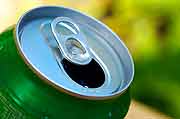
MONDAY, Feb. 6 (HealthDay News) — New research shows that the pancreas has sweet-taste receptors — like those found on the tongue — that can “taste” fructose.
Fructose is a common ingredient in many foods and beverages. Nutrition experts have warned that Americans take in far too much fructose and the new findings might bolster their concerns.
In lab studies of pancreas cells from both humans and mice, the researchers found that when the pancreas tastes fructose from foods, it responds by producing more insulin. Insulin is a hormone that allows sugar from the blood to enter the body’s cells. However, excess levels of insulin, or an inefficient use of insulin, have been linked to obesity and type 2 diabetes, the researchers said.
“The coolest thing in my mind is that we now understand that taste isn’t only for the tongue. We have a whole slew of cells for controlling how we deal with sugars,” said the study’s senior author, Bjorn Tyrberg, an assistant professor and scientific advisor in histology and cellular imaging at the Sanford-Burnham Medical Research Institute in Orlando, Fla.
He added that fructose had not been linked to insulin secretion in the past, but that this study shows when the pancreas tastes fructose, there is an effect on insulin secretion when glucose is also present.
Fructose and glucose are two different types of sugars. Fructose is found naturally in things like fruit and honey. One source of fructose, called high-fructose corn syrup, is added to many processed foods, such as sodas and cereals, according to Tyrberg.
What isn’t yet clear, he said, is what effect fructose has on the body’s metabolism. “We’ve shown that fructose is not inert with insulin secretion,” he said, but added that whether this connection plays a role in obesity or the development of type 2 diabetes isn’t known.
Results of the study appear online Feb. 7 in the Proceedings of the National Academy of Sciences.
Normally, when you eat, beta cells in the pancreas respond to the rise in glucose levels by secreting more insulin. Insulin attaches to other cells in the body and opens the cells, allowing glucose to enter the cells and provide energy. But researchers wanted to know what role fructose played in the release of insulin.
Using cells from humans and mice, the researchers found that fructose activated sweet-taste receptors on beta cells, causing them to secrete insulin. When glucose and fructose were encountered together, as would often happen with commonly consumed foods today, even more insulin was released.
When the researchers inactivated — or turned off — the sweet-taste receptors in the beta cells, they no longer secreted insulin when exposed to fructose. The researchers say these findings suggest that these sweet-taste receptors in the pancreas may play a role in metabolic diseases, such as obesity and type 2 diabetes. They’re currently developing studies in humans to confirm what they’ve found in human and mouse cells in the lab.
Commenting on the study, Dr. Spyros Mezitis, an endocrinologist and clinical investigator at Lenox Hill Hospital in New York City, said that it showed that “when you eat fructose and glucose together, you get even more of an insulin release. That means sugar gets out faster, and the body is pushed harder.”
And, he added, “if you have a high sugar consumption, you may tire out your pancreas, and that exhaustion might cause the pancreas to not release enough insulin anymore. If you already have type 2 diabetes, this could push the body more and hasten the progression of the disease.”
But “right now this is speculation. We need human studies to understand this connection over time,” Mezitis said. Still, this may be “one more piece of evidence that we should be curtailing fructose in our diets,” he suggested.
A spokesperson for the Corn Refiners Association declined to comment on the study’s findings.
More information
Learn more about type 2 diabetes from the U.S. National Library of Medicine.

